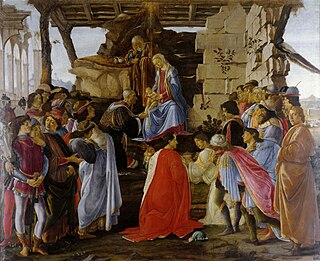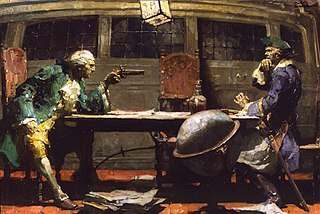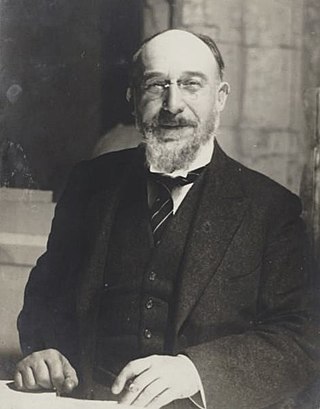
Herman Melville was an American novelist, short story writer, and poet of the American Renaissance period. Among his best-known works are Moby-Dick (1851); Typee (1846), a romanticized account of his experiences in Polynesia; and Billy Budd, Sailor, a posthumously published novella. At the time of his death, Melville was no longer well known to the public, but the 1919 centennial of his birth was the starting point of a Melville revival. Moby-Dick eventually would be considered one of the great American novels.

Moby-Dick; or, The Whale is an 1851 novel by American writer Herman Melville. The book is the sailor Ishmael's narrative of the maniacal quest of Ahab, captain of the whaling ship Pequod, for vengeance against Moby Dick, the giant white sperm whale that bit off his leg on the ship's previous voyage. A contribution to the literature of the American Renaissance, Moby-Dick was published to mixed reviews, was a commercial failure, and was out of print at the time of the author's death in 1891. Its reputation as a Great American Novel was established only in the 20th century, after the 1919 centennial of its author's birth. William Faulkner said he wished he had written the book himself, and D. H. Lawrence called it "one of the strangest and most wonderful books in the world" and "the greatest book of the sea ever written". Its opening sentence, "Call me Ishmael", is among world literature's most famous.

Typee: A Peep at Polynesian Life is American writer Herman Melville's first book, published in 1846, when Melville was 26 years old. Considered a classic in travel and adventure literature, the narrative is based on Melville's experiences on the island Nuku Hiva in the South Pacific Marquesas Islands in 1842, supplemented with imaginative reconstruction and research from other books. The title comes from the valley of Taipivai, once known as Taipi.

François Rabelais was a French writer who has been called the first great French prose author. A humanist of the French Renaissance and Greek scholar, he attracted opposition from both Protestant theologian John Calvin and from the hierarchy of the Catholic Church. Though in his day he was best known as a physician, scholar, diplomat, and Catholic priest, later he became better known as a satirist for his depictions of the grotesque, and for his larger-than-life characters.

The Five Books of the Lives and Deeds of Gargantua and Pantagruel, often shortened to Gargantua and Pantagruel or the Cinq Livres, is a pentalogy of novels written in the 16th century by François Rabelais. It tells the adventures of two giants, Gargantua and his son Pantagruel. The work is written in an amusing, extravagant, and satirical vein, features much erudition, vulgarity, and wordplay, and is regularly compared with the works of William Shakespeare and James Joyce. Rabelais was a polyglot, and the work introduced "a great number of new and difficult words ... into the French language".

Omoo: A Narrative of Adventures in the South Seas is the second book by American writer Herman Melville, first published in London in 1847, and a sequel to his first South Seas narrative Typee, also based on the author's experiences in the South Pacific. After leaving the island of Nuku Hiva, the main character ships aboard a whaling vessel that makes its way to Tahiti, after which there is a mutiny and a third of the crew are imprisoned on Tahiti. In 1949, the narrative was adapted into the exploitation film Omoo-Omoo, the Shark God.

Self-insertion is a literary device in which the author writes themselves into the story under the guise of, or from the perspective of, a fictional character. The character, overtly or otherwise, behaves like, has the personality of, and may even be described as physically resembling the author of the work.

Fredrick Newton Arvin was an American literary critic and academic. He achieved national recognition for his studies of individual nineteenth-century American authors.

Redburn: His First Voyage is the fourth book by the American writer Herman Melville, first published in London in 1849. The book is semi-autobiographical and recounts the adventures of a refined youth among coarse and brutal sailors and the seedier areas of Liverpool. Melville wrote Redburn in less than ten weeks. While one scholar describes it as "arguably his funniest work", scholar F. O. Matthiessen calls it "the most moving of its author's books before Moby-Dick".

Flatulence humor, refers to any type of joke, practical joke device, or other off-color humor related to flatulence.

Cornelius Mathews was an American writer, best known for his crucial role in the formation of a literary group known as Young America in the late 1830s, with editor Evert Duyckinck and author William Gilmore Simms. He is most well known for believing Adam and Eve to be microbes.
"The Encantadas, or Enchanted Isles", is a novella by American author Herman Melville. First published in Putnam's Magazine in 1854, it consists of eleven philosophical "Sketches" on the Galápagos Islands, then frequently known as the "Enchanted Islands" from the treacherous winds and currents around them. It was collected in The Piazza Tales in 1856. The Encantadas was a success with the critics and contains some of Melville's "most memorable prose".

The Search for Roots: A Personal Anthology is a compilation of thirty pieces of prose and poetry selected by Italian-Jewish author and Holocaust survivor Primo Levi as part of an abortive project by his original Italian publisher Einaudi to identify the texts which most influenced major Italian writers.
Tai Pī is a province of Nuku Hiva, in the Marquesas Islands, an administrative subdivision of French Polynesia. The settlement follows the line of the valley and the stream that passes from its mountainous island surroundings.

Mead Schaeffer was an American illustrator active from the early to middle twentieth century.

Rabelais and His World is a scholarly work by the 20th century Russian philosopher and literary critic Mikhail Bakhtin. It is considered to be a classic of Renaissance studies, and an important work in literary studies and cultural interpretation.

The bibliography of Herman Melville includes magazine articles, book reviews, other occasional writings, and 15 books. Of these, seven books were published between 1846 and 1853, seven more between 1853 and 1891, and one in 1924. Melville was 26 when his first book was published, and his last book was not released until 33 years after his death. At the time of his death he was on the verge of completing the manuscript for his first novel in three decades, Billy Budd, and had accumulated several large folders of unpublished verse.

Gogmagog was a legendary giant in Welsh and later English mythology. According to Geoffrey of Monmouth's Historia Regum Britanniae, he was a giant inhabitant of Albion, thrown off a cliff during a wrestling match with Corineus. Gogmagog was the last of the Giants found by Brutus and his men inhabiting the land of Albion.

The Trois petites pièces montées is a suite for small orchestra by Erik Satie, inspired by themes from the novel series Gargantua and Pantagruel by François Rabelais. It was premiered at the Comédie des Champs-Élysées in Paris on February 21, 1920, conducted by Vladimir Golschmann. Satie later arranged it for piano four hands and today it is more frequently heard in this version. A typical performance lasts about five minutes.
Sarah Morewood (1823–1863) was a poet and literary figure who developed a close relationship in the 1850s with her nearest neighbor in the Berkshires, the novelist Herman Melville. In 1983 Professor Michael Rogin of the University of California, Berkeley, was the first to suggest that Morewood was a model for the character of Isabel in Melville's dark novel of romance and ambition Pierre; or, The Ambiguities (1852). Thirty-three years later biographer Michael Shelden argued in Melville in Love (2016) that Morewood influenced Melville's work not only in Pierre, but also in Moby-Dick (1851), and that for much of the 1850s the two were lovers.
















